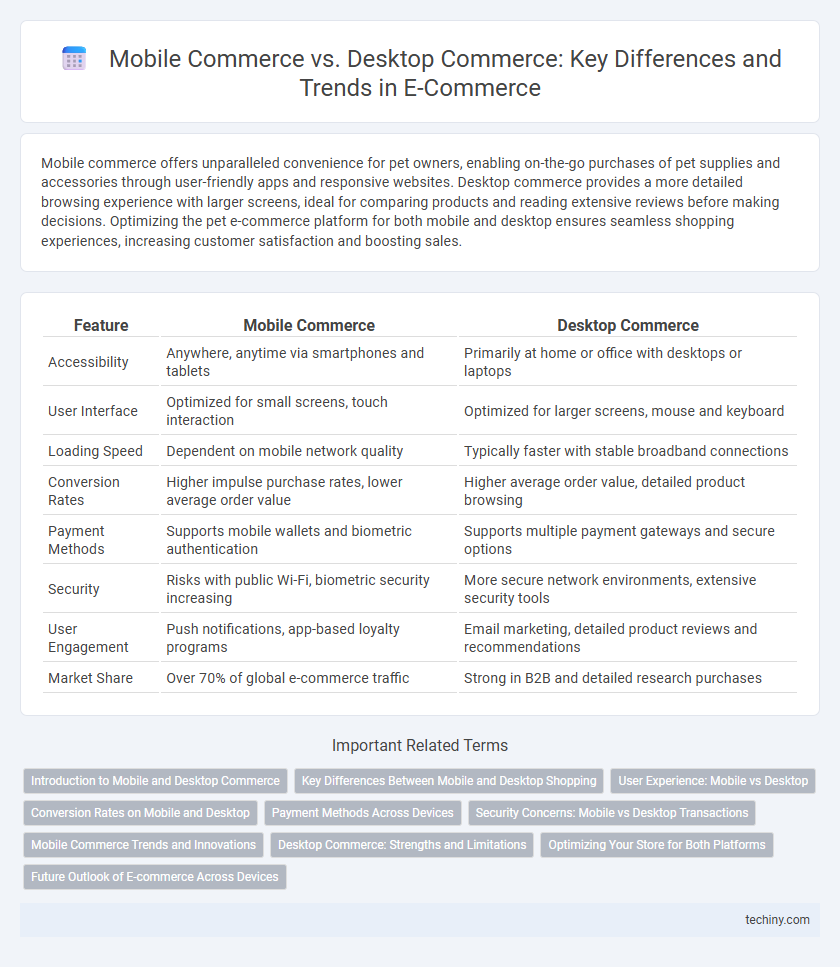Mobile commerce offers unparalleled convenience for pet owners, enabling on-the-go purchases of pet supplies and accessories through user-friendly apps and responsive websites. Desktop commerce provides a more detailed browsing experience with larger screens, ideal for comparing products and reading extensive reviews before making decisions. Optimizing the pet e-commerce platform for both mobile and desktop ensures seamless shopping experiences, increasing customer satisfaction and boosting sales.
Table of Comparison
| Feature | Mobile Commerce | Desktop Commerce |
|---|---|---|
| Accessibility | Anywhere, anytime via smartphones and tablets | Primarily at home or office with desktops or laptops |
| User Interface | Optimized for small screens, touch interaction | Optimized for larger screens, mouse and keyboard |
| Loading Speed | Dependent on mobile network quality | Typically faster with stable broadband connections |
| Conversion Rates | Higher impulse purchase rates, lower average order value | Higher average order value, detailed product browsing |
| Payment Methods | Supports mobile wallets and biometric authentication | Supports multiple payment gateways and secure options |
| Security | Risks with public Wi-Fi, biometric security increasing | More secure network environments, extensive security tools |
| User Engagement | Push notifications, app-based loyalty programs | Email marketing, detailed product reviews and recommendations |
| Market Share | Over 70% of global e-commerce traffic | Strong in B2B and detailed research purchases |
Introduction to Mobile and Desktop Commerce
Mobile commerce involves purchasing goods or services through smartphones and tablets, leveraging apps and responsive websites for convenience and on-the-go accessibility. Desktop commerce, on the other hand, uses traditional computers with larger screens, offering detailed product views and extensive navigation capabilities. Understanding the distinctions impacts user experience design, payment methods, and marketing strategies in e-commerce platforms.
Key Differences Between Mobile and Desktop Shopping
Mobile commerce emphasizes speed and convenience with touch-friendly interfaces and location-based services, driving impulsive purchases and on-the-go shopping. Desktop commerce offers comprehensive product displays, advanced filtering options, and enhanced security features, catering to detailed research and bulk ordering. User behavior diverges as mobile shoppers prefer quick, streamlined checkouts, while desktop users engage in prolonged browsing and comparative analysis.
User Experience: Mobile vs Desktop
Mobile commerce offers a streamlined, intuitive user experience with touch-friendly interfaces and faster load times optimized for smaller screens, boosting conversion rates on smartphones and tablets. Desktop commerce provides more comprehensive navigation and detailed product displays, catering to users seeking in-depth information and multitasking capabilities with larger monitors. Prioritizing responsive design and seamless checkout processes enhances user satisfaction across both platforms, driving higher engagement and sales.
Conversion Rates on Mobile and Desktop
Mobile commerce conversion rates typically lag behind desktop commerce due to smaller screens and slower input methods, averaging around 1.8% compared to desktop's 3.5%. However, advancements in responsive design, faster mobile checkout processes, and mobile payment options are steadily closing this gap. Retailers optimizing for mobile experiences often see significant improvements in conversion rates, driven by enhanced usability and streamlined navigation tailored for handheld devices.
Payment Methods Across Devices
Mobile commerce offers diverse payment methods such as digital wallets (Apple Pay, Google Pay), mobile banking apps, and one-tap payments optimized for touchscreens, enhancing convenience and security. Desktop commerce typically supports more traditional payment options including credit cards, PayPal, and detailed invoicing, catering to users who prefer comprehensive transaction reviews. Optimizing payment methods across devices increases conversion rates by aligning with user preferences and device capabilities in e-commerce environments.
Security Concerns: Mobile vs Desktop Transactions
Mobile commerce transactions face unique security challenges such as increased vulnerability to public Wi-Fi attacks and device theft, necessitating robust encryption and multi-factor authentication. Desktop commerce benefits from more controlled environments and often stronger firewall protections but remains susceptible to phishing and malware risks. Both platforms require continuous security updates and user education to safeguard sensitive payment information effectively.
Mobile Commerce Trends and Innovations
Mobile commerce continues to dominate e-commerce growth with innovations such as progressive web apps, voice-activated shopping, and AI-powered personalized recommendations enhancing the user experience. Mobile payment solutions, including digital wallets and biometric authentication, significantly increase transaction security and convenience. The rise of 5G technology further accelerates mobile commerce by enabling faster load times and seamless integration of augmented reality for interactive shopping.
Desktop Commerce: Strengths and Limitations
Desktop commerce offers superior processing power and larger displays, enhancing user experience with detailed product views and seamless multitasking capabilities. Its limitations include reduced portability and lower convenience compared to mobile devices, restricting shopping primarily to fixed locations. Despite this, desktop-commerce remains preferred for complex purchase decisions requiring extensive research and comparison.
Optimizing Your Store for Both Platforms
Optimizing your e-commerce store for both mobile commerce and desktop commerce requires responsive design that adapts seamlessly to various screen sizes and device capabilities. Prioritize fast loading times, intuitive navigation, and secure payment gateways to enhance user experience across smartphones, tablets, and desktops. Leveraging analytics to understand user behavior on each platform enables targeted customization and improved conversion rates.
Future Outlook of E-commerce Across Devices
Mobile commerce is projected to dominate the future of e-commerce with an expected global market value surpassing $700 billion by 2025, driven by increasing smartphone penetration and improved mobile payment technologies. Desktop commerce continues to maintain significant sales volume, particularly in categories requiring detailed product research or higher price points, but its growth rate is slower compared to mobile platforms. Advances in 5G connectivity, AI-driven personalization, and seamless omnichannel integration will enhance user experience across both devices, ensuring a more unified and efficient shopping journey.
Mobile Commerce vs Desktop Commerce Infographic

 techiny.com
techiny.com